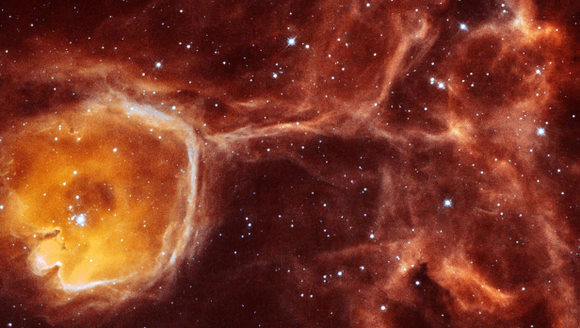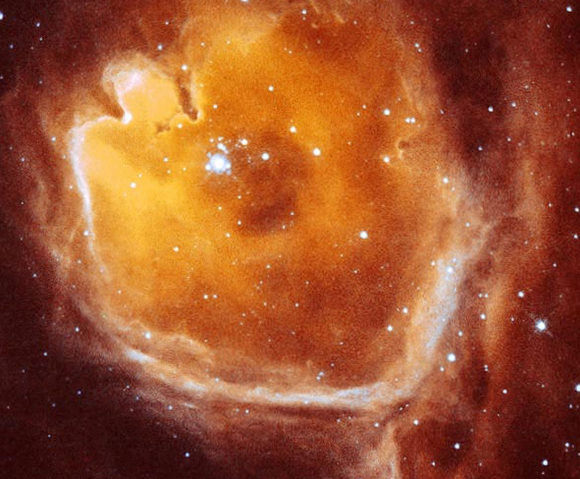Betcha thought I forgot about this week’s “Where In the Universe” challenge. Sorry its late, but summer is the time for vacations and partaking in hobbies like rock hunting and late night stargazing. Here’s an image that might provide the opportunity for both. That’s just a little hint for this week’s challenge. Your mission, should you choose to accept, is to name the location in the universe this image was taken, or maybe in this instance, what this is an image of. Give yourself extra points if you can name the spacecraft responsible for the image (that might be the easy part this week). No peeking below until you make your guess. And to be honest, I should say that this image is part of a larger image, which can be seen below.

In this unusual image, the Hubble Space Telescope captures a rare view of the celestial equivalent of a geode — a gas cavity carved by the stellar wind and intense ultraviolet radiation from a hot young star. The object, called N44F, is being inflated by a torrent of fast-moving particles –a stellar wind –from an exceptionally hot star once buried inside a cold dense cloud. N44F is located about 160,000 light-years in our neighboring dwarf galaxy the Large Magellanic Cloud, in the direction of the southern constellation Dorado.
Real geodes are baseball-sized, hollow rocks that start out as bubbles in volcanic or sedimentary rock. Only when these geodes are split in half by a geologist, do we get a chance to appreciate the inside of the rock cavity that is lined with crystals. In the case of Hubble’s 35 light-year diameter “celestial geode” the transparency of its bubble-like cavity of interstellar gas and dust reveals the treasures of its interior.
Compared with our Sun, the central star in N44F is ejecting more than a 100 million times more mass per second. The hurricane of particles moves much faster at about 4 million miles per hour (7 million kilometers per hour), as opposed to about 0.9 million miles per hour (1.5 million kilometers per hour) for our Sun. Because the bright central star does not exist in empty space but is surrounded by an envelope of gas, the stellar wind collides with this gas, pushing it out, like a snowplow. This forms a bubble, whose striking structure is clearly visible in the crisp Hubble image.
How’d everyone do?
Find the original image here.


I thought it was some kind of nebula, but that’s as far as I got! Fantastic description of this cosmic geode 🙂
Cheers, Ian
I got the Hubble! But I was thinking either a piece of Pillars of Creation, or some nebula I have no clue about, but I randomly guessed N44F as the name and ended up getting it right.
except that last part didn’t happen.
awesome challenge, yet again, Nancy!
P.s. you’re listed as a hero of mine on my MySpace. I’m serious.
At first glance I knew… that the only way I was going to nail this one was if I had a huge amount of luck.
Which I didn’t.
I did guess Hubble, but only because of your clue that the spacecraft should be the easy part. As for the object, I hesitantly thought it might be some place in the Orion molecular cloud, although I was puzzled at the graininess of the photo. That was way off.
I have a doubt, though, and you may consider this as an idea for a post, if you think it’s worth one: why is it that we see the back “wall” of the bubble, we see the side walls, but we don’t see the front wall?
N44E? Arrgh, its N44F. Darn. Well, I guessed Hubble since I’m tired and thats the only thing I could think of to take this pic. But I had really no idea.
Great pic though. Thanks, Nancy. I hope you’re having a great summer.
Got the fact that it was a Hubble picture.
Didn’t get the actual object – I was rubbish
I could’ve got it if it wasn’t for them meddlin’ kids!
Curses!!
I got that as Hubble but thats as far as i got… 🙁 Never in my life would i have guess N44F…
It is amazing pic though….i was mesmerized…
Thanks Nancy…
Like everyone else I got the spacecraft, but not the location. Cool image. It does look like a cosmic geode.
Aww shucks, James, that’s sweet- thanks!
Jorge- that’s a good question, I’ll see if I can check on that.
Thanks!
Nancy
Cool!
(I have a suspicion that it might be the same kind of phenomenon that explains why we see glass (or images in it) if the light source shining on it is between us and the glass, but don’t if the light source is beyond the glass, but a confirmation – or not – would be really cool)
The ‘front’ half of the nebula is certainly there, and could be detected as an absorption spectrum. the reason we see the other hemisphere of the nebula is that the gas is reflecting the light from the central source back toward us. The closer hemisphere is reflecting light, but the light being reflected travels in a direction away from us. The only light we see from the nebula is that which happened to pass completely through the closer hemisphere without being reflected or absorbed.
Funny that you should refer to geodes as “baseball-sized” hollow rocks (actually, some are MUCH larger, and many much smaller), because my initial thought when I saw the picture was that it could have been named the “Catcher’s Mitt” nebula. That’s what it looked like to me!
Gorgeous, GORGEOUS picture. Thank you!!!
Arrrrrgggghhhh!! I’m adequately humbled. A rock?? Some hint! I could only come up with a meteoroid impact which seemed silly. And it was! I settled on one of those mysterious far-out lightning bolts that occur in the distant atmosphere.. I’m down 4 of the 15 and crying!
Am I right to say that there is a young star in each pillar and the (heat, radiation or solar wind) from the surrounding older stars pushes back the dust essentially creating a pillar like structure, in this case creating a bubble as well. Or am I completely off course plz let me know…